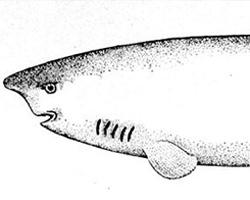
Poids et mesures
| Longueur | de 3 à 4 m |
|---|
Données biologiques
| Durée de vie | 100 r |
|---|
Statut de conservation
| Menacé |
Description de l'animal
The Greenland shark (Somniosus microcephalus), also known as the gurry shark, grey shark, or by the Inuit name Eqalussuaq, is a large and elusive species of shark that resides in the cold waters of the North Atlantic and Arctic Oceans. This remarkable creature is one of the Earth's oldest living animals, with some individuals believed to live for more than 400 years, making it the longest-living vertebrate known to science.Physically, the Greenland shark is imposing, with a robust, cylindrical body that can grow to lengths of over 6.4 meters (21 feet), though most specimens are somewhat smaller. Its skin is rough and dark, ranging from brownish to grayish in color, which helps it camouflage in the deep, murky waters where it prefers to dwell. The shark's small eyes are often clouded by a parasitic copepod, Ommatokoita elongata, which attaches to the cornea and feeds on the shark's eye tissue, yet surprisingly does not seem to significantly impair the shark's ability to find food. This unique relationship is an example of the complex and often bizarre symbiotic relationships found in the deep sea.
The diet of the Greenland shark is varied and includes fish, squid, and even larger mammals such as seals. There have been instances where remains of polar bears, horses, and reindeer were found in their stomachs, suggesting that these sharks are not just predators but also scavengers, willing to feed on carrion they encounter in the depths. Their hunting strategy remains largely a mystery, but it is believed that they use a combination of stealth and the element of surprise in the dimly lit waters to approach their prey.
One of the most fascinating aspects of the Greenland shark is its incredibly slow metabolism and growth rate. These sharks grow at a glacial pace, only a few centimeters per year, and do not reach sexual maturity until they are around 150 years old. This slow pace of life is thought to be one of the keys to their remarkable longevity.
Despite their size and potential longevity, much about the Greenland shark remains a mystery. They are rarely observed in their natural habitat due to the depths at which they live. Research into these enigmatic creatures is challenging and often relies on accidental catches or the examination of specimens that wash ashore.
The Greenland shark's flesh is toxic when fresh due to high levels of trimethylamine oxide, which converts into toxic substances when consumed. However, it can be eaten if properly processed, a practice that has been part of Inuit culture for centuries. The meat, known as "hakarl," is considered a delicacy in Iceland after being treated to reduce its toxicity.
Despite their fascinating nature, Greenland sharks face threats from changing ocean temperatures, pollution, and potential overfishing. While they are not currently considered endangered, their slow reproductive rate means that populations could be significantly impacted by human activities. Conservation efforts and further research are crucial to ensure the survival of this ancient and mysterious species, allowing it to continue its slow-paced life in the cold, dark depths of the ocean for centuries to come.
Carte de répartition

Nouvelles photos d'animaux
Top 10 des animaux
- Dolphin gull (Leucophaeus scoresbii)
- Diana monkey (Cercopithecus diana)
- Moustached guenon (Cercopithecus cephus)
- Galápagos tortoise (Geochelone nigra complex)
- Japanese macaque (Macaca fuscata)
- Stone loach (Barbatula barbatula)
- Russian tortoise (Testudo horsfieldii)
- Greek tortoise (Testudo graeca)
- Common flying dragon (Draco volans)
- Vendace (Coregonus albula)